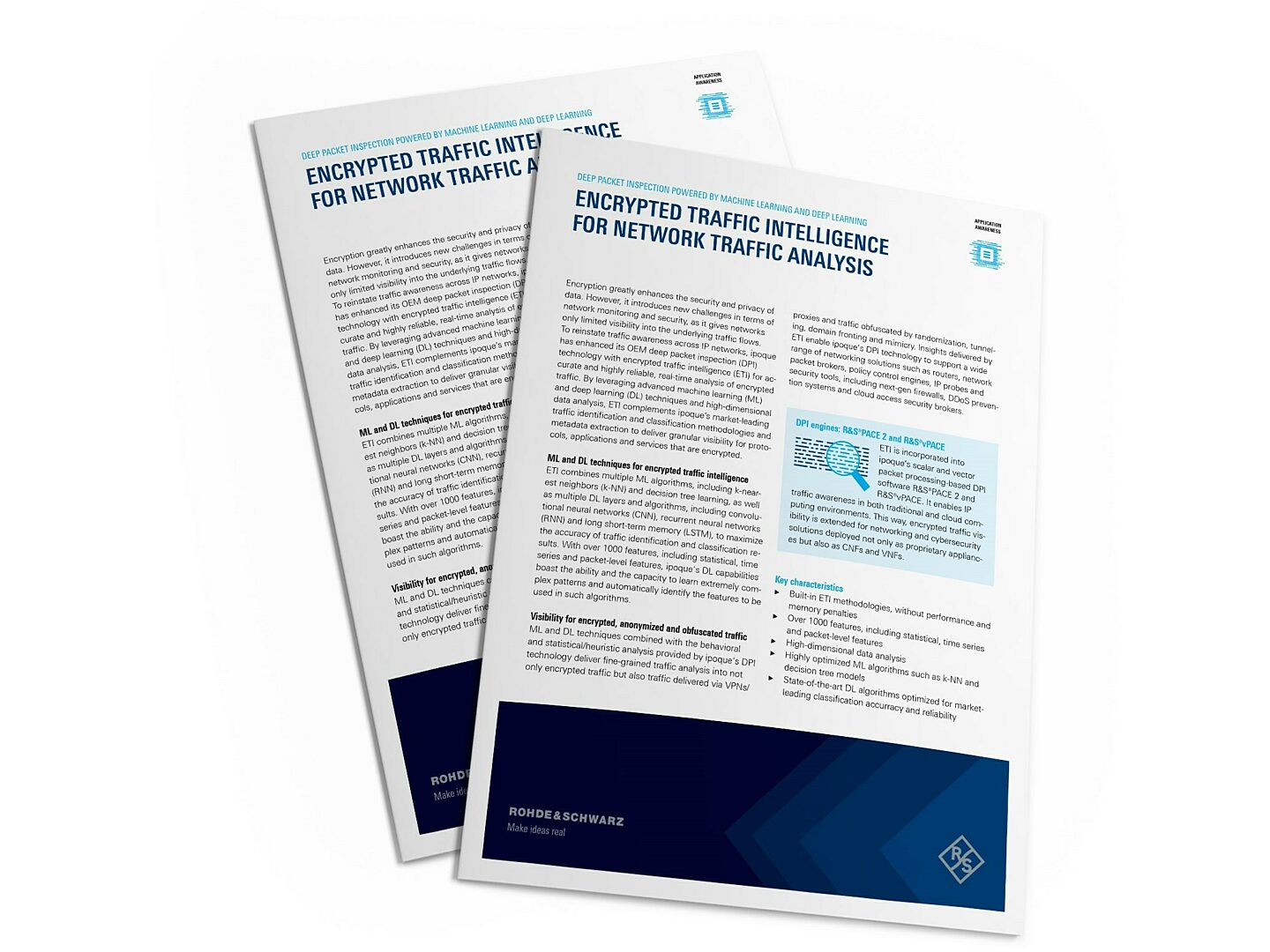By 2030, talk about cellular networks will mostly be about 6G. Whether it is quantum computing, THz communication or pervasive AI, 6G will be redefining wireless communications with peak data rates exceeding 1 Tbps (Terabits per second) and extreme low-latencies <1–10 μs1. Use cases that were unfathomable just a year ago, when LTE transitioned to 5G, will become common applications on 6G, fueling new human experiences that can be created, transported and delivered instantaneously in every corner of the world.
Given the kind of traffic and the speeds, it is expected to deliver, managing 6G requires tools far superior to what we have today. One such technology is deep packet inspection (DPI), which is rapidly transforming to meet the advanced visibility needs of IP traffic flows across cellular networks as they transition from LTE to 5G and in the not too distant future, to 6G. Cutting-edge DPI engines from ipoque, for example, which encompass the vector packet processing (VPP)-based software module R&S®vPACE and scalar packet processing-based R&S®PACE 2, are able to identify any number of flows across unlimited application and protocol types. Supported by comprehensive and up-to-date libraries, DPI software delivers a highly reliable and scalable classification of network traffic to meet a number of critical aspects of 6G network performance.
New airspace for 6G
For the first time, cellular networks will go beyond ground-level connectivity to encompass the air and space in an integrated network known as space-air-ground integrated network (SAGIN). Going beyond base stations distributed across the land, 6G will see the vertical expansion of cellular communications to cover a network of unmanned aerial vehicles (UAV) and low Earth orbit (LEO) satellites, resulting in a truly ubiquitous network. The creation of virtual networks in 6G will thus involve the abstraction of 3 layers of physical infrastructure, presenting not just new complexities in managing a network, but new visibility needs. This is where deep packet inspection becomes a very pertinent feature in 6G. By providing real-time insights into packets and flows across the network, DPI is able to maintain network observability for any link in any of the three layers within SAGIN, providing insights into the performance of each domain, application and protocol for various ends that manage 6G networks.
Such insights will be most critical2 for applications that transcend space, air and ground connectivity. These range from accident coverage to maritime monitoring, from CyberTwin in the petroleum industry to precision agriculture, from geospatial mapping to smart cities. Other applications include UAV traffic management (UTM), where ultra-low latencies provided by 6G will see thousands of UAVs navigating congested airspace leveraging real-time data connectivity for instantaneous responses and timely execution of remote instructions.
The granularity of network traffic insights provided by DPI, including a detailed breakdown of traffic by applications and their attributes, is expected to be of great value in supporting the making of the Internet of Senses, an emerging technology enabled by 6G. This involves applications such as hologram communications, pervasive AR and ultra high-fidelity AR/VR – all of which require uncompromised speeds and latencies for rapid data transfer. A glitch in the network or an error in the application code can both be identified by utilizing analytics derived from R&S®vPACE and R&S®PACE 2 before such events impact application performance.
The network visibility provided by next-gen DPI software will also be crucial in supporting the 6G versions of existing applications, namely Internet-of-Things applications. For example, DPI can aid in the creation of an Intelligent Internet of Medical Things and boost precision medicine, yielding improvements in providing care for and treating many diseases, from cancer to dementia. 3, 4
Security across space, air and ground
Access control will become far more critical in 6G than 5G simply because of the vast number of hierarchies and privileges created by network slicing that now include three access domains. Zero-trust networks are used to secure such privileges and ensure strict control across digital assets accessible via these privileges involving continual validation of user credentials. DPI provides crucial information for the enforcement of such controls by identifying abnormalities in traffic patterns and suspicious behaviors and matching these against the slices and applications to ensure that only authorized users are navigating the right instances.
SAGIN in 6G also greatly expands the network’s attack surface with the addition of UAVs and clusters of satellites to the already rapidly growing number of macro and small cells, static and mobile endpoints (such as smart meters and autonomous cars) on the ground. Hijacking and interception of the network now expand to every vulnerable node in the air and in space. Vulnerabilities in 6G are also exacerbated by the novelty of technologies such as blockchain, quantum computing, visible light communications and THz communication, all of which can be manipulated to launch attacks on the network. Many of these attack methodologies remain outside the knowledge of operators. In this scenario, behavioral, statistical and heuristic methods coupled with ML/DL and high-dimensional analysis deployed by R&S®vPACE and R&S®PACE 2 can be used to detect suspicious traffic patterns in real time, even for encrypted, obfuscated and anonymized traffic. R&S®vPACE more specifically offers vectoring-ready APIs and improved CPU-cycles-per-packets that enables the exponential rise in traffic processing expected in 6G.
Fueling 6G intelligence
6G will see a lot of manual feeds in network configuration being replaced by a complex web of AI-based inputs used to form and manage a range of functions across OSI layers. These functions may include beam management, channel allocation, interference management, the invocation of security VNFs as well as content compression and caching. ipoque can support operators bolster network automation with highly reliable and accurate network traffic analysis. This paves the way not just for the provisioning of their own services, but also for enhancing 6G private networks and network-as-a-service implementations.
6G-ready, now
The arrival of 6G may take a few more years, but operators need not wait that long to develop their network intelligence capabilities. By leveraging advanced tools in network traffic visibility, existing LTE and 5G networks can be used to test, build and enhance these capabilities for an early start towards 6G readiness and to the ultimate realization of the next level of human experience when the time comes.
Sources
[1] https://www.techtarget.com/searchnetworking/definition/6G
[2]
https://www.sciencedirect.com/science/article/pii/S1319157821002172
[3]
https://arxiv.org/pdf/2005.07532.pdf
[4] https://www.jmir.org/2022/4/e30503











